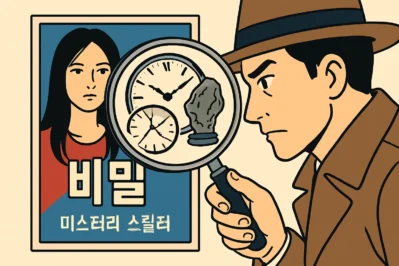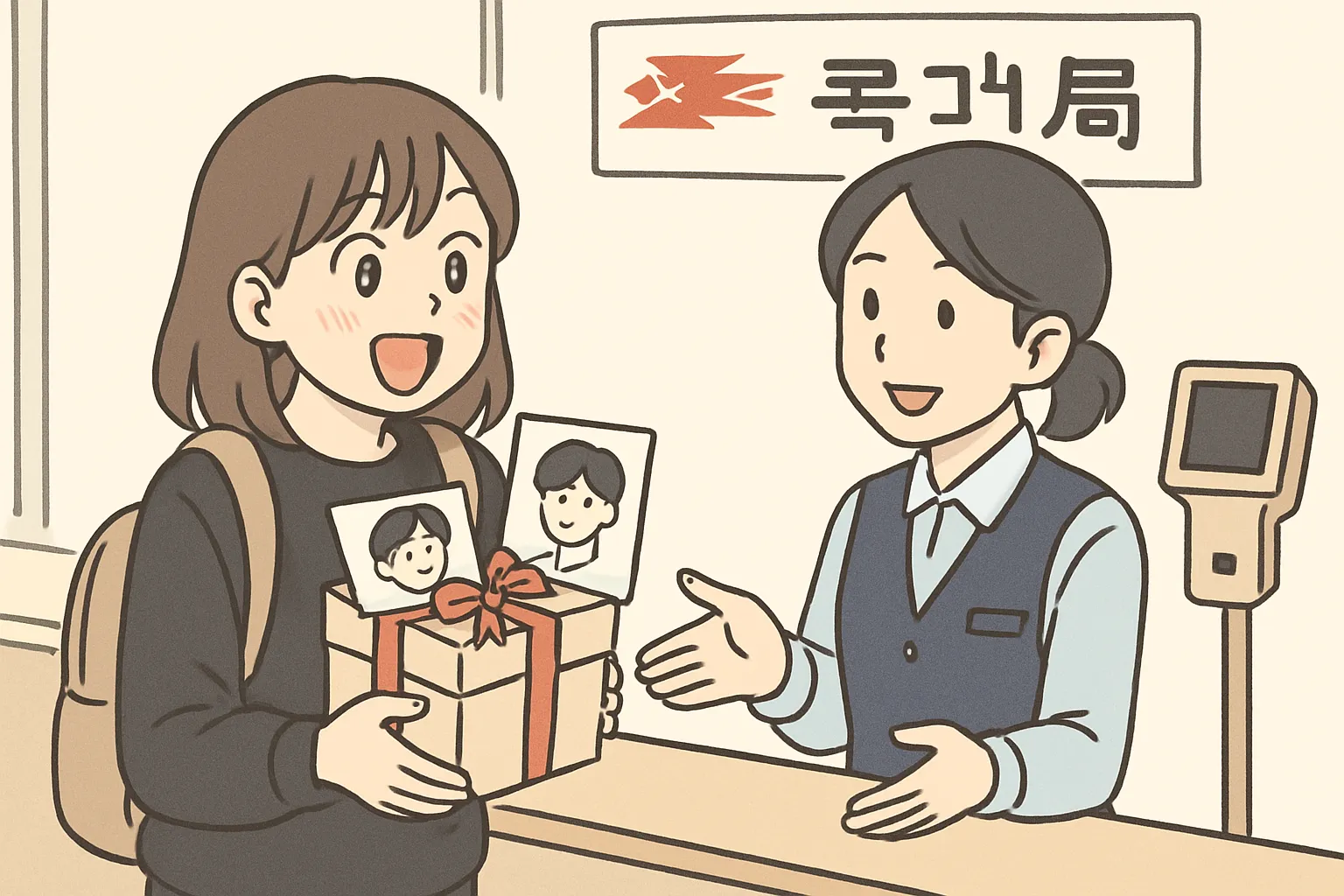Crack the Code: Unlocking Korean Art’s Hidden Messages!
Hello! Welcome to Maeil Hangeul, the place to upgrade your Korean skills!
Have you ever watched a Korean drama or movie and felt like there was a deeper meaning you were just missing? You’re not alone! Today, we’re going to learn the Korean expressions you need to become a cultural detective and uncover the secret messages hidden in art.
These days in Korea, from the Oscar-winning film Parasite to popular webtoons and modern art, creators are embedding powerful social commentary into their work. Learning to talk about these hidden meanings won’t just improve your Korean—it will give you a key to understanding the heart of modern Korean culture. Let’s dive in!
Core Expressions for Your Detective Toolkit
Here are four essential expressions to help you analyze and discuss art like a pro.
1. 숨은 의미 (Sumeun uimi)
- Pronunciation [Romanization]: Sumeun uimi
- English Meaning: Hidden meaning; subtext
- Detailed Explanation: This is your go-to phrase for talking about symbolism. 숨은 (Sumeun) is the past participle form of the verb 숨다 (sumda), which means “to hide.” 의미 (Uimi) means “meaning.” So, literally, it’s a “hidden meaning.” You can use it to talk about anything with a deeper layer, from a painting to a line of dialogue in a drama. It’s a neutral expression that works in both casual and formal settings.
- 💡 Pronunciation Tip: The final consonant
ㄴ (n)in 숨은 (sumeun) links smoothly to the vowel으 (eu)in 의미 (uimi). So, instead of a choppy “sum-eun ui-mi,” try to say it fluidly as [su-meu-nui-mi]. It will make you sound much more natural!
2. ~을/를 상징하다 (~eul/reul sangjinghada)
- Pronunciation [Romanization]: ~eul/reul sangjinghada
- English Meaning: To symbolize ~
- Detailed Explanation: This is the essential verb for art analysis! It means “to symbolize.” The structure is [Noun]을/를 상징하다. Use 을 (eul) if the noun ends in a consonant and 를 (reul) if it ends in a vowel.
- Example: 비둘기는 평화를 상징해요. (Bidulgineun pyeonghwareul sangjinghaeyo.) = The dove symbolizes peace.
- 💡 Pronunciation Tip: In Korean, the
ㅎ (h)sound can sometimes be very soft or even disappear when it’s between voiced sounds. While the standard pronunciation is [sangjinghada], in fast speech, you might hear it sound closer to [sangjingada]. For now, focus on pronouncing theㅎ (h)clearly to be precise.
3. 비판적인 시각 (Bipanjeogin sigak)
- Pronunciation [Romanization]: Bipanjeogin sigak
- English Meaning: A critical perspective / viewpoint
- Detailed Explanation: This phrase is perfect for discussing art that offers commentary on society. 비판적 (Bipanjeok) means “critical,” and 시각 (sigak) means “viewpoint” or “perspective.” You can use it like this: “이 영화는 사회에 대한 비판적인 시각을 보여줘요.” (I yeonghwaneun sahoe-e daehan bipanjeogin sigageul boyeojwoyo.) = “This movie shows a critical perspective on society.” It’s a slightly more academic term, but it will make you sound incredibly smart!
- 💡 Pronunciation Tip: The final
ㄱ (k)in 시각 (sigak) is an “unreleased” consonant. This means you form the ‘k’ sound with your tongue but don’t release a puff of air. It should sound like a soft, abrupt stop: [sigak̚].
4. 의도 (Uido)
- Pronunciation [Romanization]: Uido
- English Meaning: Intention; purpose
- Detailed Explanation: What was the artist thinking? To ask this, you need the word 의도 (uido). It refers to the creator’s purpose or intention behind their work. It’s a very common and useful noun.
- Example: 작가의 의도가 무엇일까요? (Jakga-ui uidoga mueosilkkayo?) = What do you think the artist’s intention is?
- 💡 Pronunciation Tip: The vowel 의 (ui) can be tricky. When it’s at the beginning of a word like in 의도 (uido), you should pronounce both the
으 (eu)andㅣ (i)sounds distinctly: [ui-do]. However, as we saw in 숨은 의미, when의is not the first syllable, it’s often simplified to an [i] sound. Practice makes perfect!
Example Dialogue: At the Art Gallery
Let’s see these expressions in action! Two friends, A and B, are at a modern art museum.
A: 와, 이 그림 좀 봐. 색깔이 정말 강렬하다.
(Wa, i geurim jom bwa. Saekkkari jeongmal gangnyeolhada.)
Wow, look at this painting. The colors are so intense.B: 응, 작가의 의도가 뭘까? 그냥 아름다움을 표현한 걸까?
(Eung, jakga-ui uidoga mwolkka? Geunyang areumdaumeul pyohyeonhan geolkka?)
Yeah, I wonder what the artist’s intention was. Do you think it’s just expressing beauty?A: 글쎄… 나는 사회에 대한 비판적인 시각을 담은 것 같아. 저기 저 깨진 시계는 잃어버린 시간을 상징하는 것 아닐까?
(Geulsse… Naneun sahoe-e daehan bipanjeogin sigageul dameun geot gata. Jeogi jeo kkaejin sigyeneun ireobeorin siganeul sangjinghaneun geot anilkka?)
Hmm… I think it contains a critical perspective on society. Don’t you think that broken clock over there symbolizes lost time?B: 아! 듣고 보니 그렇네. 정말 숨은 의미가 많은 작품이다.
(A! Deutgo boni geureone. Jeongmal sumeun uimiga maneun jakpumida.)
Ah! Now that you mention it, that makes sense. This piece really has a lot of hidden meanings.
Culture Tip: The Parasite Effect
Remember the “scholar’s rock” (수석) in the globally famous movie Parasite (기생충)? Director Bong Joon-ho himself said it’s full of 숨은 의미 (sumeun uimi).
On the surface, it 상징하다 (sangjinghada) the Kim family’s desire for wealth and status. However, it also becomes a heavy burden they can’t get rid of, and eventually, a weapon. This is a perfect example of how Korean creators use everyday objects to present a sharp, 비판적인 시각 (bipanjeogin sigak) on social issues like class inequality.
Next time you watch a Korean film or drama, pay close attention to the props. Try to figure out the director’s 의도 (uido). You’ll unlock a whole new layer of the story and appreciate the artistry even more!
Let’s Review and Practice!
Great job today! We learned four fantastic expressions to help you discuss the deeper meanings in Korean art and media: 숨은 의미 (hidden meaning), ~을/를 상징하다 (to symbolize), 비판적인 시각 (critical perspective), and 의도 (intention).
Now, it’s your turn to be the critic!
- Fill in the blank:
이 영화에서 비(rain)는 가난한 사람들의 슬픔을 __________.
(I yeonghwa-eseo bineun gananhan saramdeurui seulpeumeul __________.)
In this movie, the rain __________ the sadness of the poor. -
Your turn!
Think about a movie or drama you watched recently. What 숨은 의미 did you find?
(최근에 본 영화나 드라마에 어떤 숨은 의미가 있었나요?)
Leave your answers in the comments below using the expressions we learned today. We can’t wait to read your amazing insights






